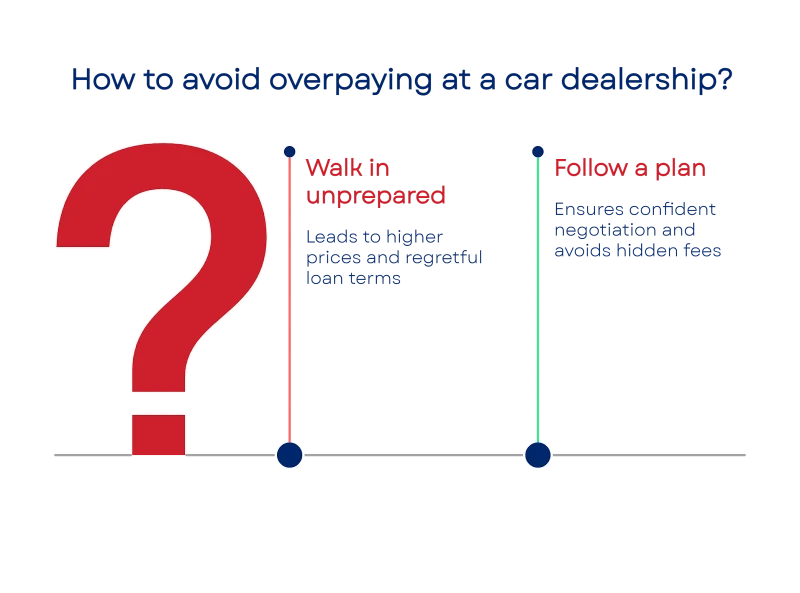The biggest mistake that costs buyers thousands
What’s the biggest mistake people make when buying a used Toyota or any car from a dealership? It’s one that can lead to overpaying by thousands — especially when purchasing out of state.
Many buyers walk in without a clear plan, unsure what to say, what paperwork to review, or when it’s best to walk away. That leaves them vulnerable to higher prices, unnecessary extras, and loan terms they later regret.
When you follow the proven steps in this guide, you’ll be prepared to negotiate confidently, check the correct details, and avoid hidden fees. You’ll leave the dealership with the right used Toyota or any car at the right price, whether you're buying locally or buying a car out of state.
What You’ll Learn
In this guide, you’ll find clear answers to three key questions every smart car buyer asks before visiting a dealership:
How can you prepare ahead of time so you stay focused and avoid overpaying?
What should you pay attention to and avoid during the test drive and negotiations?
How can you review the final paperwork and delivery to catch hidden fees or mistakes?
By the end, you’ll know exactly how to buy a car from a dealership with confidence, save money, and avoid the common mistakes that unprepared buyers often make.
Summary
Buying a car from a dealership can be a straightforward process if you prepare correctly. Here’s a concise, step-by-step guide for American buyers:
1. Before You Go
Set your budget: Use the 20/4/10 rule: 20% down, 4-year loan, payments ≤10% of gross income.
Research models & prices: Check the MSRP and what others are paying on Edmunds, Kelley Blue Book, and TrueCar.
Get pre-approved financing: Secure loan terms from your bank or credit union to compare with dealer offers.
Gather documents: Driver’s license, proof of insurance, payment for down payment; if trading in, bring title, registration, and pay-off info.
2. At the Dealership
Test drive: Inspect the interior and exterior, adjust the seating, test on varied roads, and try parking maneuvers.
Negotiate the out-the-door (OTD) price: Focus on the total cost (vehicle, taxes, and fees), not the monthly payment. Use your research to support offers.
Compare multiple dealers: Email or call for written quotes and leverage competing offers.
3. Financing & Paperwork
Review dealer financing: They may offer promotional rates, but be aware of marked-up interest rates.
Examine all documents to verify the OTD price, fees, and VIN, and ensure that no unwanted add-ons (such as paint protection or gap insurance) are included.
4. Delivery & Inspection
Inspect again at delivery: Check for damage, verify correct features, confirm a full tank, and ensure the mileage is within the agreed-upon range.
Get a walkthrough: Learn key features: safety systems, infotainment setup, and maintenance schedule.
5. Timing & Tips
Best times to buy: End of month/quarter/year and model-year clearances (late summer to early fall).
Red flags: Pressure to buy now, refusal to provide written OTD pricing, hidden fees. Be ready to walk away.
By researching, focusing on the total price, and verifying every detail, you’ll confidently secure a fair deal and drive away satisfied.
Why Preparation Matters
Buying a car from a dealership without preparation is like taking an exam without studying. You might get through it, but the result will likely cost you more than you expected.
Dealerships count on buyers showing up overwhelmed and impulsive. That makes it easier to sell unnecessary extras, mark up prices, and push loan terms that don’t fit your budget.
A small amount of preparation changes everything. When you know what to expect, what to ask, and what to check, you stay in control of the process and avoid costly mistakes.
Before You Go: Prepare Like a Pro
What you do before visiting the dealership has the most significant impact on your experience and the price you pay. Follow these steps carefully to walk in confidently, informed, and ready to make wise decisions.
Step 1: Set your budget
Use the 20/4/10 rule to decide how much you can afford:
Plan for a down payment of at least 20 percent of the car’s price.
Keep the loan term no longer than four years to minimize interest costs.
Ensure your monthly payment remains at or below 10% of your gross monthly income.
Setting these limits protects you from overspending and keeps the purchase manageable long-term.
Step 2: Research vehicle prices
Check pricing before you go. Use tools like:
Edmunds
Kelley Blue Book
TrueCar
Look up the manufacturer’s suggested retail price (MSRP) and compare it with what others in your area are paying for the same make, model, and trim. This provides you with a fair price range to target and strengthens your position during negotiations.
Step 3: Get pre-approved financing
Contact your bank or credit union to get pre-approved for a loan. A pre-approval provides a clear interest rate and terms that you can compare against any dealer financing offer. It also shows the dealer you already know what you qualify for.
Step 4: Decide if you will trade in your current vehicle
If you plan to trade in a car, research its current market value on Edmunds or Kelley Blue Book. Bring the required paperwork:
Vehicle title
Current registration
Loan payoff information, if applicable
Knowing your car’s value prevents you from accepting an offer that’s too low.
Step 5: Gather all necessary documents
Bring the following items with you:
Valid driver’s license
Proof of insurance
Method of down payment (check, debit card, or as agreed)
If you are financing through the dealer, also bring proof of income if they request it.
Step 6: Research dealerships
Check online to confirm that the dealership you plan to visit has the car you want in stock. Read customer reviews to see how they handle pricing, negotiations, and customer service. Choose a dealership with a good reputation to save time and avoid unnecessary stress.
As part of your research, it helps to know where to find the best deals online. This guide to the 20 best used car sites can save you time and point you toward reputable listings.
At the Dealership: Stay in Control
Once you arrive at the dealership, it’s essential to stay focused and stick to your plan. These steps help you evaluate the car, negotiate effectively, and avoid common mistakes.
Step 1: Test drive the car properly
Take time to inspect and drive the vehicle thoroughly:
Check the exterior and interior for any damage or wear.
Adjust the seat, mirrors, and controls to your comfort.
Drive on different types of roads to see how it handles.
Test parking to assess visibility and maneuverability.
This is your opportunity to confirm that the car meets your expectations.
If you’re deciding between a certified pre-owned vehicle and a traditional used car, this comparison of CPO vs. used cars explains the key differences and which choice may suit you better.
Step 2: Negotiate the out-the-door price
Focus on the total cost of the vehicle, including taxes and fees. Dealers may steer you toward a monthly payment instead. Be firm about discussing the full price instead of payment amounts. Use your research to support your offer, and don’t be afraid to counter.
Step 3: Compare written quotes
Before making a final decision, ask for a written out-the-door price quote. Contact other dealers and request the same. Comparing offers gives you leverage to negotiate a better deal. Dealers are more likely to match or beat a competitor’s written price.
Step 4: Avoid unnecessary extras
Be cautious if the dealer offers add-ons like extended warranties, paint protection, or gap insurance without explaining the cost and benefits. Politely decline anything you don’t need. Take time to review each item before agreeing.
By following these steps, you can maintain a professional approach and make informed decisions based on your research and priorities.
To help you choose a dependable vehicle, this list of the most reliable used car brands is a good starting point.
Financing & Paperwork: Read Every Line
Once you agree on a price, the next step is to complete the financing and sign the paperwork. Take your time here to avoid hidden costs and unfavorable terms.
Step 1: Review the financing offer
If you plan to use dealer financing, compare it to the pre-approval you brought with you. Dealers sometimes offer promotional rates, but these may come with additional conditions or higher fees. Choose the financing option with the best overall terms, not just the lowest monthly payment.
Step 2: Verify the final price and terms
Before signing, check that the out-the-door price matches what you negotiated. Confirm that all taxes, fees, and agreed discounts are listed correctly. Look for hidden charges or added products you didn’t agree to.
Step 3: Check the vehicle information
Verify that the vehicle identification number (VIN) on the paperwork matches the one on the car you are buying. Ensure the make, model, color, and mileage are accurate. Mistakes here can cause problems later.
Step 4: Decline unnecessary add-ons
Dealers often offer optional products, such as paint protection, gap insurance, or extended warranties. Unless you have already decided you need them, politely decline and have them removed from the contract.
Step 5: Take your time
Do not let anyone rush you through the paperwork. Read every page carefully before signing, and ask questions if anything is unclear. A few extra minutes now can save you from unexpected costs later.
Delivery & Final Inspection: Don’t Rush
Before you drive away, take a few minutes to inspect the car again and make sure everything is in order. This final step helps catch problems before they become your responsibility.
Step 1: Inspect the car carefully
Walk around the vehicle and check for any damage to the exterior or interior. Look for scratches, dents, or stains that weren’t there during the test drive. If you find anything, point it out to the dealer before signing the delivery paperwork.
Step 2: Check the features and mileage
Ensure the car includes all the features you agreed upon, such as safety systems, infotainment setup, and accessories. Verify that the mileage on the odometer is close to what you agreed on when purchasing.
Step 3: Confirm the fuel level
Many dealerships fill the gas tank before delivery. If it is not full, ask about it before leaving.
Step 4: Ask for a walkthrough
Request a demonstration of the car’s key features. Have the dealer demonstrate how to use the safety systems, adjust the infotainment system, and follow the recommended maintenance schedule. This helps you get familiar with your new car right away.
Step 5: Keep your paperwork organized
Before leaving, collect copies of all signed documents and store them in a secure location. This includes the sales contract, financing agreement, and any warranties.
Completing this final inspection ensures you leave with exactly what you agreed to buy and no unwanted surprises.
Timing & Red Flags: Know When to Walk Away
When you buy, it can significantly impact the amount you pay, and knowing when to walk away protects you from a bad deal. Keep these points in mind.
Step 1: Choose the right time to buy
Dealerships are more likely to offer better deals at certain times. The best times include:
The end of the month is when salespeople are trying to meet quotas.
The end of a quarter or year, when dealerships are clearing out inventory.
Late summer or early fall, when new model years arrive and dealers discount the prior year’s models.
Step 2: Watch for high-pressure tactics
If you feel pushed to make a decision immediately or told you can’t take time to think, consider leaving. Pressure is often used to keep you from comparing offers or reviewing terms carefully.
Step 3: Ask for written pricing
Always request a written-out-the-door price that includes all taxes and fees. If a dealer refuses to give it to you in writing, that is a warning sign.
Step 4: Check for hidden fees
Review the contract line by line to identify any added costs that were not included in the original agreement. If you see items that weren’t discussed, ask for them to be removed.
Step 5: Be ready to walk away
If the dealer will not match your research, keeps adding fees, or ignores your concerns, it is better to leave than agree to a bad deal. There are always other vehicles and other dealerships.
By choosing the right time and watching for these red flags, you can protect yourself from common dealership tactics and maintain a professional and fair process.
With the average price of a new car now around $49,000, timing your purchase and considering used options can make a big difference.
Final Thoughts
Many buyers opt for used cars, as they offer better value and more options within their budget. As Consumer Reports notes, used vehicles have consistently provided the most significant savings, making higher-end features and trims more affordable.
With the proper preparation, you can approach the process confidently, stay focused on your goals, and avoid common mistakes.
Take time to set your budget, research fair prices, and get pre-approved financing before you go. At the dealership, stick to the total price you negotiated, review all documents carefully, and inspect the car thoroughly before driving away.
By following these steps, you’ll make informed decisions and leave with a vehicle that meets your needs at a fair price.
Need Help Shipping Your Car?
If you’re buying a car from a dealership in another state, having it shipped can save you time and keep unnecessary miles off your new vehicle. At AmeriFreight Car Shipping, we simplify the process by connecting you with trusted carriers and guiding you through each step.
We provide clear information about pricing, pickup and delivery procedures, and optional protection plans for added peace of mind. We’re here to answer your questions and help you schedule transport that fits your timeline and needs.
Contact us today to get started with car shipping that fits your needs.
Frequently Asked Questions (FAQs)
Is it advisable to get an independent mechanic’s inspection for a used car from a dealership?
Yes. It helps confirm the car’s condition and can reveal issues the dealer may have missed.
How long does the car-buying process usually take at a dealership?
It typically takes two to four hours, depending on your level of preparation and the dealership's workload.
What should I do right after driving a new car off the lot?
Update your insurance, store all paperwork safely, and review the owner’s manual and maintenance schedule.
What clauses in a purchase agreement should I check?
Look for added fees and optional extras you didn’t agree to, and ensure the VIN and agreed-upon price are correct.
Disclaimer: This article is for general informational purposes only and does not constitute legal, financial, or professional advice. Always consult qualified professionals before making major financial decisions or signing binding agreements.






















